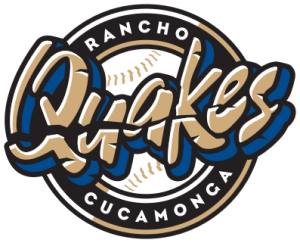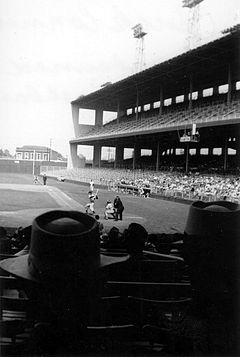
Wrigley Field is a baseball stadium on the North Side of Chicago, Illinois. It is the ballpark of Major League Baseball's Chicago Cubs, one of the city's two MLB franchises. It first opened in 1914 as Weeghman Park for Charles Weeghman's Chicago Whales of the Federal League, which folded after the 1915 baseball season. The Cubs played their first home game at the park on April 20, 1916, defeating the Cincinnati Reds 7–6 in 11 innings. Chewing gum magnate William Wrigley Jr. of the Wrigley Company acquired the Cubs in 1921. It was named Cubs Park from 1920 to 1926, before being renamed Wrigley Field in 1927. The stadium currently seats 41,649 people and is the second stadium to be named Wrigley Field, as a Los Angeles ballpark with the same name opened in 1925.

Dodger Stadium is a baseball stadium in the Elysian Park neighborhood of Los Angeles, California. It is the ballpark for Major League Baseball’s Los Angeles Dodgers. Opened in 1962, it was constructed in less than three years at a cost of US$23 million. It is the oldest ballpark in MLB west of the Mississippi River, and third-oldest overall, after Fenway Park in Boston (1912) and Wrigley Field in Chicago (1914), and is the largest baseball stadium in the world by seat capacity. Often referred to as a "pitcher's ballpark", the stadium has seen 13 no-hitters, two of which were perfect games. In addition, Dodger Stadium has been deemed the most popular MLB stadium on social media.

Angel Stadium of Anaheim, better known simply as Angel Stadium, is a baseball stadium located in Anaheim, California, United States. Since its opening 58 years ago in 1966, it has served as the home ballpark of Major League Baseball’s Los Angeles Angels. It also served as the home stadium of the Los Angeles Rams of the National Football League (NFL) from 1980 to 1994.

The Los Angeles Memorial Coliseum is a multi-purpose stadium in the Exposition Park neighborhood of Los Angeles, California, United States. Conceived as a hallmark of civic pride, the Coliseum was commissioned in 1921 as a memorial to Los Angeles veterans of World War I. Completed in 1923, it will become the first stadium to have hosted the Summer Olympics three times when it hosts the 2028 Summer Olympics; the stadium previously hosted the Summer Olympics in 1932 and 1984. It was designated a National Historic Landmark on July 27, 1984, a day before the opening ceremony of the 1984 Summer Olympics.

The Los Angeles Angels are an American professional baseball team based in the Greater Los Angeles area. The Angels compete in Major League Baseball (MLB) as a member club of the American League (AL) West division. Since 1966, the team has played its home games at Angel Stadium in Anaheim, California.

The Los Angeles Angels were a professional baseball team based in Los Angeles that played in the "near-major league" Pacific Coast League (PCL) from 1903 through 1957.
Gilmore Field was a minor league baseball park in Los Angeles, California, that served as home to the Hollywood Stars of the Pacific Coast League from 1939–1957 when they, along with their intra-city rivals, the Los Angeles Angels, were displaced by the transplanted Brooklyn Dodgers of the National League.

The Rancho Cucamonga Quakes are a Minor League Baseball team of the California League and the Single-A affiliate of the Los Angeles Dodgers. They are located in Rancho Cucamonga, California, and play their home games at LoanMart Field.

Raymond Lee Walls Jr. was an American professional baseball player, an outfielder who appeared in Major League Baseball (MLB) between 1952 and 1964 as a member of the Pittsburgh Pirates, Chicago Cubs, Cincinnati Reds, Philadelphia Phillies and Los Angeles Dodgers. He also played the 1965 season in Japan, for the Hankyu Braves. The native of San Diego threw and batted right-handed, stood 6 feet 3 inches (1.91 m) tall, and weighed 205 pounds (93 kg). Walls wore eyeglasses on the field during his active career — a rarity for players of his era — and was nicknamed "Captain Midnight" because of his eyewear.
The 1961 Los Angeles Angels season ended with the Angels finishing eighth in the American League with a record of 70–91, 38+1⁄2 games behind the World Champion New York Yankees. It was the Angels' first season in franchise history, and their only season at Wrigley Field in Los Angeles. Gene Autry owned the franchise, which was created as a counterpart to the Los Angeles Dodgers, and the two teams would even share the same stadium the following year when the Angels moved to Dodger Stadium.

The 2008 Chicago Cubs season was the 137th season of the Chicago Cubs franchise, the 133rd in the National League and the 93rd at Wrigley Field. The season began at home on March 31 against the Milwaukee Brewers. The Cubs were champions of the National League Central for the second year in a row, accumulating 97 regular season wins—the most since 1945. It was the first time since 1908 that the Cubs made postseason appearances in consecutive seasons.
The 2008 Major League Baseball season began on March 25, 2008, in Tokyo, Japan with the 2007 World Series champion Boston Red Sox defeating the Oakland Athletics at the Tokyo Dome 6–5 in the first game of a two-game series, and ended on September 30 with the host Chicago White Sox defeating the Minnesota Twins in a one-game playoff to win the AL Central. The Civil Rights Game, an exhibition, in Memphis, Tennessee, took place March 29 when the New York Mets beat the Chicago White Sox, 3–2.
The 2008 Los Angeles Dodgers season featured the Dodgers celebrating their Golden Anniversary in Southern California under new manager Joe Torre as they won the National League West for the first time since 2004, and returned to the postseason after missing the playoffs in 2007. The Dodgers did not peak until September when the won 17–8, which was highlighted by the acquisition of superstar outfielder Manny Ramirez. Ramirez hit .396 with 17 HRs in 53 games after the trade on July 31. They swept the Chicago Cubs in the NLDS to advance to the NLCS. It was their first playoff series win since 1988 when they went on to win the World Series. However, they lost to the Philadelphia Phillies in five games in the NLCS.
The 1965 Major League Baseball season was contested from April 12 to October 14, 1965. The Los Angeles Dodgers and Minnesota Twins were the regular season champions of the National League and American League, respectively. The Dodgers then defeated the Twins in the World Series, four games to three.
The 1961 Major League Baseball season was played from April 10 to October 12, 1961. That season saw the New York Yankees defeat the Cincinnati Reds in five games in the World Series. The season is best known for Yankee teammates Roger Maris' and Mickey Mantle's pursuit of Babe Ruth's prestigious 34-year-old single-season home run record of 60. Maris ultimately broke the record when he hit his 61st home run on the final day of the regular season, while Mantle was forced out of the lineup in late September due to a hip infection and finished with 54 home runs.
The 1961 Major League Baseball expansion resulted in the formation of two new Major League Baseball (MLB) franchises in the American League (AL). A new club was started in Washington, D.C., and took the existing name of the Senators, as the previous team of the same name moved to Minnesota for the start of the 1961 season and became the Twins. The second new franchise was granted to an ownership group led by Gene Autry for a team in Los Angeles who named themselves the Angels. The two new teams each paid a fee of $2.1 million and became the 17th and 18th franchises in MLB.















